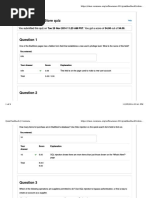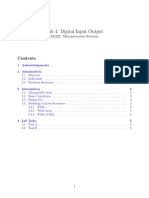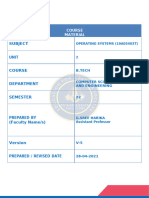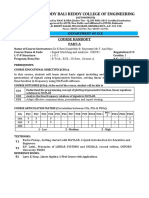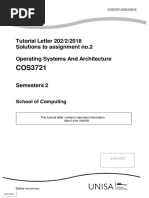Utc502 PDF
Utc502 PDF
Uploaded by
Ali HusseiniCopyright:
Available Formats
Utc502 PDF
Utc502 PDF
Uploaded by
Ali HusseiniOriginal Title
Copyright
Available Formats
Share this document
Did you find this document useful?
Is this content inappropriate?
Copyright:
Available Formats
Utc502 PDF
Utc502 PDF
Uploaded by
Ali HusseiniCopyright:
Available Formats
Machine Translated by Google
Lebanese University Date: February 2023 Semester: 2
ISSAE - Cnam Lebanon Duration: 120 minutes Year: 2022-2023
Lebanon Center associated with Cnam Paris Topic coordinated by: Rachid Aoun
Exam language: French
EU Code: UTC502
This subject contains: 6 pages
Course title: Fundamentals of Operating Systems
Type of exam : Semester Partiel Final Catch-up
Annual E1 E'1 E2 E'2
Authorized documents All None Other specify ………………………………………….)
Special instructions: All exercises are compulsory
Calculator : None Programmable Not programmable
Centers concerned Beirut Baalbeck Baaklin Bickfaya Nahr Ibrahim Chtoura Tripoli
Exercise 1 Question Scale Duration (minutes) 15
- 2.5
To 3 18
2
b 1 6
To 2 12
3
b 2 12
To 1.5 9
b 0.5 3
4
vs 0.5 3
d 0.5 3
To 0.5 3
5 b 1.5 9
vs 0.5 3
6 - 22 12
7 - 12
UTC502 - Fundamentals of Operating Systems – 1st semester – Final 2022 2023 1
Machine Translated by Google
EXERCISE 1 – Main memory management (2.5 marks)
Consider a system that uses allocation by variable partitions. We consider at time t the
following state of the central memory. (The gray partitions are free partitions):
Use the Best Fit choice in order to represent the evolution of the central memory according
to the arrival of the following successive events:
ÿ Arrival of program F (8 K) ÿ
Departure of program C ÿ Arrival of
program G (20k) ÿ Departure of
program E ÿ Arrival of program H
(12k)
EXERCISE 2 – Scheduling of processes (4 dots)
That is 4 processes P1, P2, P3 and P4 using independent input/output units.
P1 P2 P3 P4
Calculation 2 ms Calculation 2 ms Calculation 2 ms Calculation 6 ms
I/O 6ms I/O 6ms I/O 8ms I/O 2ms
Calculation 2 ms Calculation 6 ms Calculation 4 ms Calculation 4ms
I/O 4ms I/O 2ms I/O 6ms I/O 1ms
Calculation 4ms Calculation 1 ms Calculation 1 ms
I/O 1ms I/O 1ms I/O 2ms
a) On the chronogram below represent the evolution of these 4 processes, while
indicating their ready, blocked and elected states, in each of the following
algorithms:
• By preemptive priority (with priority (p2) > priority (p3) > priority (p1) >
priority (p4))
• By turnstile initial order p1, p2, p3 then p4 (with a quantum Q=2ms).
The process leaving the elected state places itself in the queue at the end of
the list.
b) In each of the algorithms, calculate the average waiting time of each
process.
UTC502 - Fundamentals of Operating Systems – 1st semester – Final 2022 2023 2
Machine Translated by Google
Preemptive
Process P1
Elected
Ready
Blocked
P2 process
Elected
Ready
Blocked
P3 process
Elected
Ready
Blocked
P4 process
Elected
Ready
Blocked
Turnstile
Process P1
Elected
Ready
Blocked
P2 process
Elected
Ready
Blocked
P3 process
Elected
Ready
Blocked
P4 process
Elected
Ready
Blocked
UTC502 - Fundamentals of Operating Systems – 1st semester – Final 2022 2023 3
Machine Translated by Google
EXERCISE 3: Segmentation and pagination (4 dots)
We consider a memory for which the central memory cells are 2 KB.
The main memory has a total of 30 spaces numbered from 1 to 30 for the user space.
In this context, we consider four processes A, B, C and D.
Process A: its address space is segmented and paginated composed of three
segments AS1, AS2 and AS3, each divided into two pages.
Process B: its address space is made up of 2 segments BS1 and BS2, one made up
of one page and the second made up of three pages.
Process C: its address space is made up of a CS1 segment of 2 pages.
Process D: its address space is made up of three segments DS1, DS2 and DS3.
DS1 is made up of two pages, DS2 and DS3 are made up of three pages each.
For process A, only page 1 of segment AS1, pages 1 and 2 of segment AS2 are
loaded in central memory respectively in boxes 2, 8, 12.
For process B, page 1 of segment BS1 and page 1 and 3 of BS2 are loaded into
central memory in boxes 5, 6, 14 respectively.
For process C, only page 2 of segment CS1 is loaded into central memory in box 18.
For process D, page 1 of segment DS1, pages 2 and 3 of segment DS2 are loaded in
boxes 9, 10 and 17.
a) Represent on a drawing the structures allocated for this type of memory
allocation and the central memory corresponding to the allocation described. b)
The 2 processes A and B are described by a control block which also contains the
following information:
• For process A, ordinal counter CO = (AS2, P2, displacement 16), page
table address = 128; • For process B, ordinal counter CO = (BS2, P1,
displacement
512), page table address = 256;
ÿ Process A becomes active. What value does the PTBR register contain?
Which physical address corresponds to the virtual address of the executed
instruction?
ÿ Now process A is preempted and process B is elected. Briefly describe the
context switching operation that takes place, in particular by giving the new
values of the CO and PTBR registers.
UTC502 - Fundamentals of Operating Systems – 1st semester – Final 2022 2023 4
Machine Translated by Google
ÿ Each page table entry contains a bit field to specify the access rights
associated with a page. This field is made up of three bits x, r, w with the
following meaning:
x: 0 no execute permission on page, 1 execute permission granted r:
0 no read permission on page, 1 read permission granted w: 0 no
write permission on page, 1 write permission granted This "right" field
to the value 011 for page P1 of segment AS1 of process A. Process A
executes the instruction STORE R1 (AS1, P1, move 128) which performs
the writing of the contents of the processor register R1 to the address
(AS1, P1, displacement 128). What is going on ?
EXERCISE 4: Memory management (3 points)
Consider a paged segmentation memory system i.e. each segment is divided into
pages. This memory includes a large number of segments so that the segment
table must itself be paged. The logical address will have the following form :
Moving in the
Descriptor table page Moving in the
descriptor table Segment page number
number segment page
page
Segment number Movement in the segment The logical
address will be made up of several fields. Our memory has the following
characteristics:
• virtual addresses of length 36 bits, • page
size = 4 KB, • page table entry = 64 bits, (a
page table of a segment occupies at least
maximum one page),
• segment table entry = 128 bits, a) Give
the model of the logical address which corresponds to this system by specifying
the number of bits of each field of this address.
b) What is the maximum number of
segments. c) What is the maximum size of a
segment. d) What is the size of the entire memory.
EXERCISE 5: File Management System (2.5 marks)
A 16 GB Unix file, written in disk blocks of 4 Kbytes. Knowing that a block number
occupies 2 bytes.
a) What is the number of data blocks in the file? b)
What is the total number of blocks in the file (data and index) ?
UTC502 - Fundamentals of Operating Systems – 1st semester – Final 2022 2023 5
Machine Translated by Google
c) Give the total number of disk accesses necessary, with or without management of
caching mechanism.
EXERCISE 6: Synchronization between processes (2 points)
We consider three processes P1, P2, P3 whose characteristics are as follows
Priority (lower value = higher priority)
Arrival date
Execution time
P1 0 8 units 3
P2 3 7 units 1
P3 5 9 units 2
The three processes are scheduled according to a policy of preemptive priorities.
It is assumed that the 3 processes use the same critical resource R.
The process steps are as follows:
P1 P2 P3
Calculation during 1 unit Calculation during 1 unit Calculation during 4 units
Take(R) Take(R) Take(R)
Use R for 7 units Use R for 5 units Use R for 5 units
Render (R) Render (R) Render (R)
Calculation during 1 unit
Build the execution schedule of the three processes taking into account the sharing of the R resource.
Exercise 7: Deadlock (2 points)
On a computer, 8 processes ranging from P1 to P8 have access to 6 exclusive access resources ranging from
R1 to R6 as follows:
• Process P1 holds R2 and requests R3. • Process P2
holds R5 and requests R6. • Process P3 holds R4 and
requests R5. • Process P4 does not hold any resources
but requests R5. • Process P5 holds R1 and requests R6. • Process P6 holds R3
and requests R4 • Process P7 holds R6 • Process P8 does not hold any resources
but requests R3
After reading how resources are held or requested, is there a risk of deadlock? If so, what are the processes
involved?
UTC502 - Fundamentals of Operating Systems – 1st semester – Final 2022 2023 6
You might also like
- Bad Store Project 2 QuizDocument9 pagesBad Store Project 2 QuizEswar Hari Kumar100% (1)
- EPC Level 3 ScheduleDocument72 pagesEPC Level 3 ScheduleGeetha_jagadish3075% (4)
- Problem Bank 28Document8 pagesProblem Bank 28Rosaria SammuelsNo ratings yet
- Utc501 PDFDocument2 pagesUtc501 PDFAli HusseiniNo ratings yet
- End-Of-Chapter ProblemsDocument7 pagesEnd-Of-Chapter ProblemsSheila CortezNo ratings yet
- CH 04Document111 pagesCH 04JessicaNo ratings yet
- Summary Notes Year 7Document5 pagesSummary Notes Year 7Cinara Rahimova100% (3)
- Expert Schematic DiagramsIIDocument80 pagesExpert Schematic DiagramsIIMauro AzzaliniNo ratings yet
- OSCMExercises1 190416 WITHSOLUTIONSDocument16 pagesOSCMExercises1 190416 WITHSOLUTIONSManuel ManuNo ratings yet
- QMB - Session 19 - Worksheet 18 - Winter 2020 PDFDocument4 pagesQMB - Session 19 - Worksheet 18 - Winter 2020 PDFGrace StylesNo ratings yet
- Structured LightDocument10 pagesStructured LightKopkoHNo ratings yet
- CSCI380-Week 5-Lecture 1-Pert ChartDocument5 pagesCSCI380-Week 5-Lecture 1-Pert Chart12110159No ratings yet
- Chapter 5 DSDocument33 pagesChapter 5 DSSentayehu GirmaNo ratings yet
- PPSC Me1 2022 23 QPDocument2 pagesPPSC Me1 2022 23 QPsriramula7025No ratings yet
- Arid Agriculture University, Rawalpindi: Office of The Controller of ExaminationsDocument8 pagesArid Agriculture University, Rawalpindi: Office of The Controller of ExaminationsBOBBY BEATSNo ratings yet
- 10-White Box TestingDocument30 pages10-White Box Testinghastigerina pingkanNo ratings yet
- Lab 4: Digital Input Output: EE222: Microprocessor SystemsDocument5 pagesLab 4: Digital Input Output: EE222: Microprocessor SystemsALI HAIDERNo ratings yet
- Mini Project Pid Design and TuningDocument5 pagesMini Project Pid Design and TuningfaranimohamedNo ratings yet
- PSC Unit 2Document22 pagesPSC Unit 2p.deekshithreddy05No ratings yet
- 19CS502 Os MNKDocument4 pages19CS502 Os MNKMadhu C KNo ratings yet
- Hierachies 2022Document44 pagesHierachies 2022mizapranNo ratings yet
- Sauce & Spoon Project Plan: MilestoneDocument54 pagesSauce & Spoon Project Plan: MilestonePhi Hiep Nguyen0% (1)
- Final 30 Day PlannerDocument24 pagesFinal 30 Day Planner20BCO546 SANJIV SUNDARNo ratings yet
- LAB 10 RISC-V Assembly (Part II) : EE-222 Microprocessor SystemsDocument5 pagesLAB 10 RISC-V Assembly (Part II) : EE-222 Microprocessor SystemsShanawar AliNo ratings yet
- OS Course Material UNIT 2Document99 pagesOS Course Material UNIT 2Ramu gopireddyNo ratings yet
- Nfa004 PDFDocument3 pagesNfa004 PDFAli HusseiniNo ratings yet
- 19CS502 Os NTVDocument5 pages19CS502 Os NTVMadhu C KNo ratings yet
- T1010 - Mathematics N3 April QP 2021Document9 pagesT1010 - Mathematics N3 April QP 2021Hope MulijaniNo ratings yet
- MDC 1 MathematicsDocument3 pagesMDC 1 Mathematicsshahidvava3999No ratings yet
- Assignment 3: First Semester Session 1441/1442 AHDocument5 pagesAssignment 3: First Semester Session 1441/1442 AHABDULRAHIM ABBAS BAZINo ratings yet
- Lec-5 LoB PDFDocument19 pagesLec-5 LoB PDFRajesh ThoratNo ratings yet
- Activity Template - Project PlanDocument48 pagesActivity Template - Project PlanEva AizupieteNo ratings yet
- 2023-07-12 Part II RT-AutomationDocument2 pages2023-07-12 Part II RT-Automationtheroules26No ratings yet
- Further Fractions and DecimalsDocument5 pagesFurther Fractions and Decimalsdurgakalyani.dNo ratings yet
- CSE 410 Exam 2Document8 pagesCSE 410 Exam 2puppychow155No ratings yet
- Computer Aided Design DAE21502 Instruction Sheet: Lab No. Lab Title Semester Session Lab Durations Independent StudiesDocument15 pagesComputer Aided Design DAE21502 Instruction Sheet: Lab No. Lab Title Semester Session Lab Durations Independent StudiesAdib IdrisNo ratings yet
- AS1114_LA&DE_CD_2024-2025.pptDocument2 pagesAS1114_LA&DE_CD_2024-2025.pptParineeta jainNo ratings yet
- Unit 2 Performance Evaluations: Structure NosDocument18 pagesUnit 2 Performance Evaluations: Structure Nosatul srivastavaNo ratings yet
- Business Accounting SyllabusDocument4 pagesBusiness Accounting Syllabusitsteesha2244No ratings yet
- Lab Manual - DroneDocument8 pagesLab Manual - DroneAuris DesignsNo ratings yet
- hw5 SolsDocument8 pageshw5 SolsmNo ratings yet
- 6.4 - Linear Programming - Simplex Method of LPP - Minimization ModelDocument3 pages6.4 - Linear Programming - Simplex Method of LPP - Minimization ModelAdhikari IshwarNo ratings yet
- Operating SystemDocument2 pagesOperating SystemVamsi KrishnaNo ratings yet
- Ict NotesDocument3 pagesIct NotesSajid bhattiNo ratings yet
- Date Tracker Gantt Chart1Document6 pagesDate Tracker Gantt Chart1abhimanue1986No ratings yet
- Comp B 60 DLDA Term Work Shashank RaiDocument51 pagesComp B 60 DLDA Term Work Shashank Raishashank raiNo ratings yet
- Chapter 4 - Models & Methods in Shop Scheduling IVDocument6 pagesChapter 4 - Models & Methods in Shop Scheduling IVfeliperaphaelliNo ratings yet
- OM Final - EXAM, G 2WF., Alaa AboualiDocument8 pagesOM Final - EXAM, G 2WF., Alaa AboualiAlaa AboaliNo ratings yet
- anupam-jana2024-07-17 09_54_19Document2 pagesanupam-jana2024-07-17 09_54_19anupamiocl2No ratings yet
- Module 2.0 - Pert-CpmDocument9 pagesModule 2.0 - Pert-CpmTyron TayloNo ratings yet
- Network Analysis Techniques - PERTDocument30 pagesNetwork Analysis Techniques - PERTGaurav SinghNo ratings yet
- HW 17 Isb 2015Document11 pagesHW 17 Isb 2015cvikasguptaNo ratings yet
- EMDDocument9 pagesEMDhoxariw435No ratings yet
- StableLM-3B-4E1T - Stable-Lm - Weights & BiasesDocument15 pagesStableLM-3B-4E1T - Stable-Lm - Weights & Biasesouaatoufatima2No ratings yet
- .CRB - SCH - Rev - 2 - 0 IntelCorei7 Processor and Intel Corei5 Processor PlatformDocument72 pages.CRB - SCH - Rev - 2 - 0 IntelCorei7 Processor and Intel Corei5 Processor PlatformAlejandro FernandezNo ratings yet
- SMA LAb Course HandoutDocument4 pagesSMA LAb Course HandoutrajNo ratings yet
- CSCI380-Week 4-Lecture 2-Gantt ChartDocument3 pagesCSCI380-Week 4-Lecture 2-Gantt Chart12110159No ratings yet
- Chapter 9 Project Scheduling (Pert CPM)Document38 pagesChapter 9 Project Scheduling (Pert CPM)Lara FloresNo ratings yet
- Operations Research Elective 3 1 0 4: 3/2/1: High/Medium/LowDocument10 pagesOperations Research Elective 3 1 0 4: 3/2/1: High/Medium/LowNAJIYA NAZRIN P NNo ratings yet
- Computer Programming BNR20803 Group Project SEM1 2021/2022Document2 pagesComputer Programming BNR20803 Group Project SEM1 2021/2022Izzul HakimNo ratings yet
- COS3721 TL 202 2 2018 B PDFDocument10 pagesCOS3721 TL 202 2 2018 B PDFThanyani SirumulaNo ratings yet
- Test ( (I + 8) % 10) Test ( (I + 2) % 10) : Part Correct: 3 Marks Entire: 8 MarksDocument3 pagesTest ( (I + 8) % 10) Test ( (I + 2) % 10) : Part Correct: 3 Marks Entire: 8 Markssai nikhilNo ratings yet
- 1.1 Well Reservoir Facility Management (WRFM) 1 2 1.2 Manage Threats & Opportunities (MTO) 1 1.3 Ptme (Pmte) 1 1.4 5 Yearly As-Built 1 2Document8 pages1.1 Well Reservoir Facility Management (WRFM) 1 2 1.2 Manage Threats & Opportunities (MTO) 1 1.3 Ptme (Pmte) 1 1.4 5 Yearly As-Built 1 2nelsonNo ratings yet
- White Box TestingDocument17 pagesWhite Box TestingdR_nechNo ratings yet
- Business Process Model and Notation based on BPMN™ 2 Fundamental CoursewareFrom EverandBusiness Process Model and Notation based on BPMN™ 2 Fundamental CoursewareNo ratings yet
- ICDL Computer Essentials Sample Part-TestDocument2 pagesICDL Computer Essentials Sample Part-TestAli HusseiniNo ratings yet
- Sample Part-Test: ICDL Computer EssentialsDocument3 pagesSample Part-Test: ICDL Computer EssentialsAli HusseiniNo ratings yet
- Let's Do It 1Document2 pagesLet's Do It 1Ali HusseiniNo ratings yet
- Nfa004 PDFDocument3 pagesNfa004 PDFAli HusseiniNo ratings yet
- Utc504 PDFDocument2 pagesUtc504 PDFAli HusseiniNo ratings yet
- Utc505 PDFDocument3 pagesUtc505 PDFAli HusseiniNo ratings yet
- StorageDocument2 pagesStorageAli HusseiniNo ratings yet
- SpringbokDocument1 pageSpringbokAli HusseiniNo ratings yet
- Blue CraneDocument1 pageBlue CraneAli HusseiniNo ratings yet
- PPS Question Bank (Amiraj)Document4 pagesPPS Question Bank (Amiraj)gjpatel047No ratings yet
- CH 08Document8 pagesCH 08Ingi Abdel Aziz Srag0% (1)
- Ceh V6Document19 pagesCeh V6Tolu OlusakinNo ratings yet
- Document PDFDocument173 pagesDocument PDFpolo007mxNo ratings yet
- DX DiagDocument29 pagesDX DiagFahlevi DzulfikarNo ratings yet
- Swagelok-Hose and Flexible Tubing CatalogDocument109 pagesSwagelok-Hose and Flexible Tubing CatalogDağhan ArpacıNo ratings yet
- Robot Monitoring of Power SystemsDocument23 pagesRobot Monitoring of Power SystemsJashuva Kiran86% (14)
- Pre Technical and Career StudiesDocument30 pagesPre Technical and Career StudiesAshline100% (1)
- Quiz 3Document4 pagesQuiz 3Sergio Yepes PorrasNo ratings yet
- Solder - Paste - Research Paper PDFDocument46 pagesSolder - Paste - Research Paper PDFGopichand VadlamanuNo ratings yet
- Centrifugal Pump With Helicoidal Impeller: I ApplicationDocument2 pagesCentrifugal Pump With Helicoidal Impeller: I ApplicationAbraham Campos ValenciaNo ratings yet
- Physical OpticsDocument26 pagesPhysical OpticsLuo MarkNo ratings yet
- CET-II Chapter 1 Vapour-Liquid Equilibrium - Part 1Document29 pagesCET-II Chapter 1 Vapour-Liquid Equilibrium - Part 1Dhruv RanaNo ratings yet
- Mean Forcast Error (MFE)Document4 pagesMean Forcast Error (MFE)raymond baliteNo ratings yet
- Data File InstructionsDocument8 pagesData File InstructionsWedaje AlemayehuNo ratings yet
- Lesson 2Document38 pagesLesson 2Ankit NehraNo ratings yet
- Tsunami Visualization WorkflowDocument2 pagesTsunami Visualization WorkflowalexinorbitNo ratings yet
- Shankar Vallabhajosula (Auth.) - Molecular Imaging - Radiopharmaceuticals For PET and SPECT-Springer Berlin Heidelberg (2009)Document379 pagesShankar Vallabhajosula (Auth.) - Molecular Imaging - Radiopharmaceuticals For PET and SPECT-Springer Berlin Heidelberg (2009)Lakshmi Nandan BaruahNo ratings yet
- Chem 26.1 Lab ManualExpts3-5Document18 pagesChem 26.1 Lab ManualExpts3-5Dam Yeo WoolNo ratings yet
- MCTS: Microsoft Silverlight 4 Development (70-506) Certification GuideDocument35 pagesMCTS: Microsoft Silverlight 4 Development (70-506) Certification Guidejagdevs7234No ratings yet
- PhysRev.67.39 Gabriel Kron, Electric Circuit Models of The Schrödinger Equation, May 1944Document5 pagesPhysRev.67.39 Gabriel Kron, Electric Circuit Models of The Schrödinger Equation, May 1944indal1No ratings yet
- Basic Engine: Drain Water From Fuel Tank Experiment of Generating Moisture BeadDocument5 pagesBasic Engine: Drain Water From Fuel Tank Experiment of Generating Moisture Beadraymond ngoNo ratings yet
- IGCSE Physics Mass WeightDocument17 pagesIGCSE Physics Mass WeightVijay Bhaskar100% (2)
- Tesla Coil Final Year ProjectDocument12 pagesTesla Coil Final Year ProjectPeerzada Wahid100% (2)
- Dsine MCCBDocument28 pagesDsine MCCBryreddyNo ratings yet
- EC204 Analog Integrated CircuitsDocument2 pagesEC204 Analog Integrated CircuitsBonifus Parambaloth Leenus100% (1)
